
For someone used to living in a lavish air-conditioned residence, having gun-toting securitymen and travelling in a convoy of cars, the 15 ft x 10 ft cell at Tihar Jail would sure resemble hell.
Dravida Munnetra Kazhagam chief M Karunanidhi's daughter Kanimozhi, who is currently cooling her heels in a cell in Jail No 6 for her role in the 2G spectrum case, has Madhuri Gupta (former Indian high commission official in Islamabad arrested on charges of spying), Sonu Punjaban (arrested in the biggest prostitution network in Delhi and NCR) and Sharda Jain (doing life term for her role in the murder of Delhi councillor Atma Ram Gupta) for company.
As uncomfortable as it may be for her, what the Rajya Sabha MP may not realise is that there are millions of Indians who have been spent a lifetime in similar 15 ft x 10 ft accommodation.
Rediff.com's correspondents across India describe the life of a few such citizens.
Click on NEXT to read Indrani Roy Mitra's story from Kolkata...
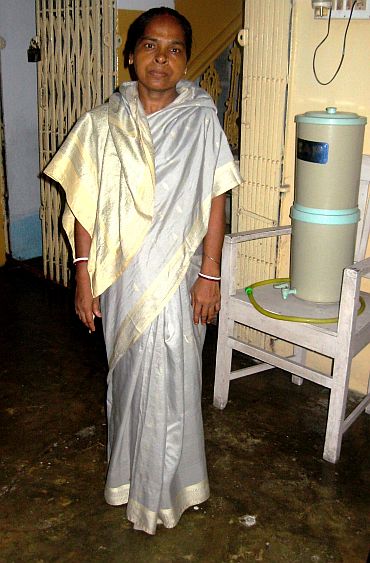
Minoti Banerjee does not know who Kanimozhi is; the word 2G is alien to her. Yet she laughs like crazy when I tell her how the Rajya Sabha MP born into luxury will be spending days in a 15 ft x 10 ft cell.
"For years I have been living in a 15 ft x 10 ft room with my twin sons, daughter and husband," Minoti, a housemaid, told rediff.com before adding, "Who is this Kanimozhi? Is she a film star?"
When updated on all the relevant details about Kanimozhi, she quipped: "Serves her right. These are bigshots, didi. At least the punishment will make her realise what we, the poorest of the poor, go through every day."
Minoti earns about Rs 3,500 a month and literally has to pinch each penny to keep her family afloat. Her husband, to quote her, is a "brute" and does not take any responsibility for his family.
"With my three kids, I have built my world in our tiny room. Apart from the roof above our heads, we have very little material possession. There is a midsize cot in one corner and a cupboard in another. My kids have been asking for a table and a chair but till now, I have not managed to save for that," Minoti said.
She never watches television at the house where she works. "For, I won't be able to buy a television set for my kids soon. I am a mother, how can I enjoy something my children can't?"
"Didi, it's a strange world. So many printed words are wasted over some tainted leader's daughter going to 15 ft x 10 ft prison cell. But nobody mentions even once how people like us struggle round the clock with a salary as meagre as Rs 3,500," she summed up.
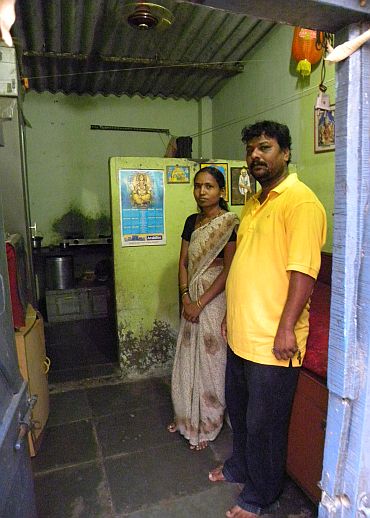
In a tiny lane that leads away from Ghodbunder Road in Thane (West), on a windy Saturday evening, life is slowly coming to a standstill. The lane that has no official name has on one side a line of warehouses and workshops and on the other a largish squatters colony.
As the warehouses and workshops are beginning to call it a week, the colony across the lane is beginning to buzz with activity. Fathers returning home, kids settling down to watch their favourite weekend television programmes and mothers preparing for the Saturday evening feast in the kitchens.
I walk into one such home -- a tiny 10 ft x 15 ft room -- with a blue door.
The couple is expecting me. As I settle into their home, Namrata pulls out a bottle of cold drink. They're a little disappointed when I turn it down and ask me for a cup of chai, an offer I cannot turn down.
Namrata Hire is a cheerful young lady in her late 20s. Her husband, Nitin (34) seems like someone who has seen some rough times.
Nitin drives a three-wheeler tempo and is on contract with a company that manufactures iron casts for heavy machinery. His job is to deliver the goods to a distributor or the airport as the requirement may be.
When he returns around 6 every evening, he steps out to chat with his friends. If he is lucky, someone hires his tempo and off he splutters in his red machine to make an extra buck.
...
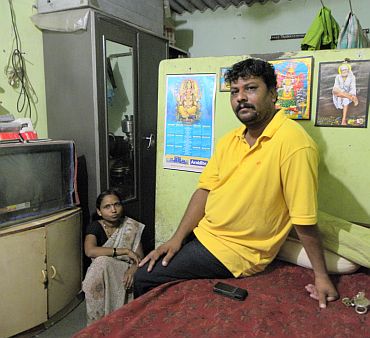
The Hires live in a home that is about 10 ft by 15 ft wide, divided by a wall that goes only half way to the ceiling.
Beyond the wall are the kitchen and an open bathroom, colloquially called a mori. The wall, I suspect, has been constructed only to keep the bathroom hidden from prying eyes.
A single fan whirs just above the partition, giving breeze to neither the living room nor the kitchen.
The 'living room' is before the partition and has a single bed and a television set with a music player mounted on a wall.
Somewhere in-between all this is a small passage where Namrata sleeps with her two children -- Vaibhav (8) and Shreyas (3). Today Namrata and her husband are by themselves.
The children are spending their summers at Namrata's parents' place Lauki Shirasgaon, a village near Nashik. Despite its size, the house is clean. The single window opens into a busy bylane as does the door. These are the only source of whatever little light and fresh air the home can get and are kept open as much as possible.
...
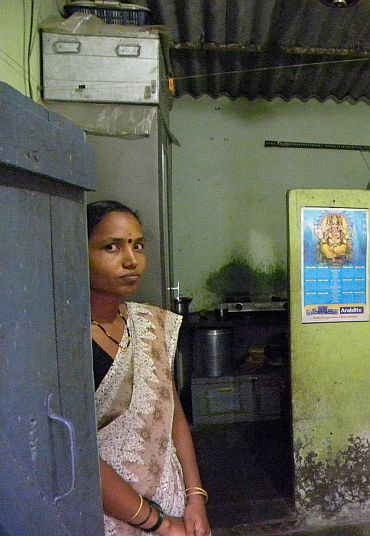
Namrata's typical day starts at a little past 5. She cooks for her husband and children, packs their lunch boxes and sees them off. Some time in the middle of all this, she also queues up at the community tap and makes at least half a dozen rounds till the 100-litre drum is full.
When the menfolk have left for the day, Namrata leaves for work herself. She goes from home to home in the tall towers across the road that house middle and upper middle class families doing their domestic chores. Namrata's neighbours have often taunted her for the work she does.
Kya bartan ghisti hai? (Why do you wash utensils?), they have said to her and her husband but the couple has turned a deaf ear to all gossip.
Namrata wasn't always a working mother. For most part, like most of her neighbours she too would be at home playing the good housewife. A year ago, her husband suddenly became bed-ridden. Fifteen years of driving the tempo and the terrible road condition had taken their toll on his back.
That's when Namrata took the reins of the house in her hands. The couple earns about Rs 12,000 between them. They spend a part of it on basic household expenses but keep away the rest to educate their two children.
"If she was educated, she wouldn't be doing this kind of (menial) job," Nitin says of his wife matter-of-factly. Then after a pause he adds, "If I was educated I wouldn't be driving a tempo either."
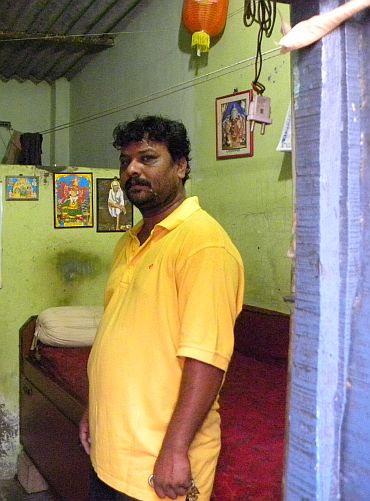
Nitin looks the kind who has seen much in life. He wears a t-shirt and jeans and has a four-day stubble. In one spot, near his chin some strands of his beard have turned unusually white, signs of creeping age.
He doesn't smile a lot and you get the feeling that he might have had some regrets.
"We didn't get the opportunity to study -- neither of us has completed our tenth (grade). Our children shouldn't be deprived of this. We've admitted Vaibhav (the older one) in an English medium school," he says with some amount of pride.
When he is ready, the younger one will also go to the same school. As soon as Vaibhav turns 12 he will be packed off to a boarding school where his father hopes he will get better education and discipline.
Nitin has spent most of his life in Thane. His father, Ratan Hire, came from Nashik to Mumbai like most others in search of a better life. At the time Nitin, second of their three sons, was but a few years old.
"We lived somewhere in Mulund before moving here," he says making a cursory wave of the hand. The room where the parents and the three brothers started their lives is right behind their own.
Ten years ago when Nitin got married, he moved into the house we are sitting in today. His older brother lives right next door and the younger one is with his parents. Before he started driving the tempo, Nitin worked briefly as an electrician. "At the time computers were new and I used to do wiring for UPS."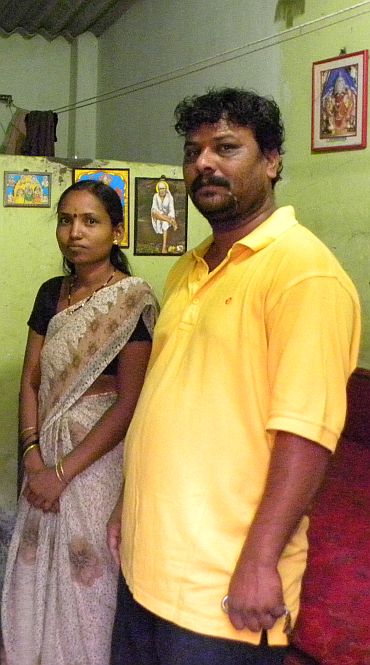
A year later he quit. Since then his workplace and home have been a hop skip and jump away.
"At that time (about 15 years ago) there was no road, no transport, none of the facilities you see today," he says not so much reminiscing of the times gone by as much as a matter of fact.
"There were tongas that would ply on the road and once in every hour you'd have an ST (State Transport) bus that would take you to Thane city. Otherwise you just had to wait."
Today, Ghodbunder Road has become the newest hub for all construction activity. The first 6 km stretch has at least a dozen malls, stores selling everything from branded clothes and furniture to imported food items that you could only dream of as a child.
As it happens that a good part of the stretch has been declared a residential area. This means companies like the ones that Nitin work for will probably sell their real estate for a whopping price and move elsewhere or simply fold up their operations.
Nitin is not sure what the future holds for him. If the insecurity of seeing his company shut shop isn't enough, he is equally scared of losing his job to immigrants.
"They are willing to work longer hours for less money," he says referring to the immigrant labour population from north India.
"They don't have families here and 10-15 of them share a small accommodation. So they can easily afford to cut their rate. I cannot afford a vacation," he points out, adding, "What if I lose my job?"
The only time he takes off during the year is for about five days when he goes off to drop his children at their grandparents' home. Otherwise he makes sure he's at work on time.
What will happen if the company were to shut down, I ask him. Nitin pauses. "Who knows," he says, "Perhaps I'll go back to Nashik."
Click on NEXT to read N Ganesh's tale of the Gaikwads from Thane in Maharashtra...
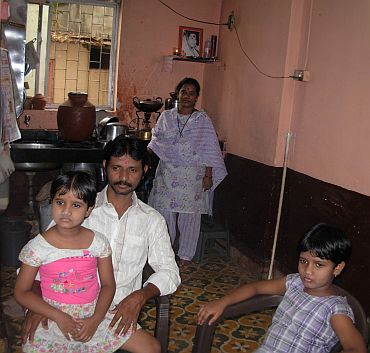
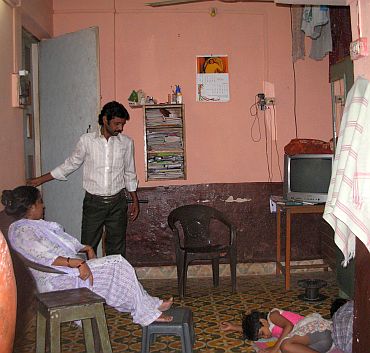

The children's books are all stored in a shelf nailed to one of the walls near the TV table.
All of Gaikwad's possessions are stored in two steel cupboards that seem to occupy a lion's share of the room. There are no cots, instead the family enjoys a good night's sleep on home made quilts, which swiftly disappear along with other bed linen into the steel cupboard when not in use.
"The television is not switched on when the children are studying in the morning and evening. Usually we do not have guests who stay overnight, but even if we do have guests we adjust," says Gaikwad.
He considers himself fortunate and rues the fact that he can only reside as a tenant in this house and cannot think of buying such a house in the near future.
Click on NEXT to read Sahim Salim's report from New Delhi...
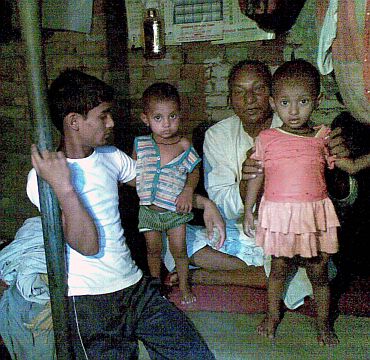
Safi Mohammad has spent his whole life in a 8 sq ft x 10 sq ft slum dwelling.
Over time, the number of members in the 68-year-old's family increased, but the size of his jhuggi has remained the same.
Today, in his dwelling in Pilanji Village, just behind New Delhi's posh Sarojini Nagar area, five other people live with him.
They include his wife Khartoom Bi, his son Tayyab, daughter-in-law Farzana and two granddaughters -- Halima and Amina.
Click on NEXT to read about the Fernandes from Mahim, Mumbai
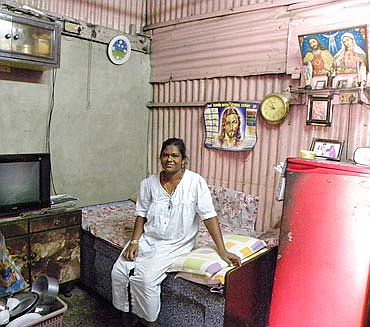
Zeta Fernandes and her husband Jerome both work to earn a "decent living". Their house is neatly done up and is furnished with a television set, a DVD player, a refrigerator and a cooking gas stove. And as they live in Mumbai they rarely face power cuts!
"I work as a maid," said Zeta, "My husband works in an industrial estate. We both earn and it is enough to meet our the basic needs."
But, living in a Mumbai slum is no cakewalk. Most days the family has a humble meal comprising dal, rice and some vegetables. On Sunday's and on occasions they cook meat.
The 10 ft x 15 ft room doubles up as a kitchen and bedroom -- they sleep on the floor.
The biggest problem they face is water shortage. "We have to store water round the year. Sometimes I have to wake up in the wee hours to fill water. Another problem that we face is sanitation. We have a common bathroom and at times sharing it with the neighbours is not easy. There are public toilets and water taps, but sanitation is poor with open sewers along the alleyways."
They have their share of problems but they face it with a smile. "It is difficult to stay in such a small space but we manage. For us this is like our palace."